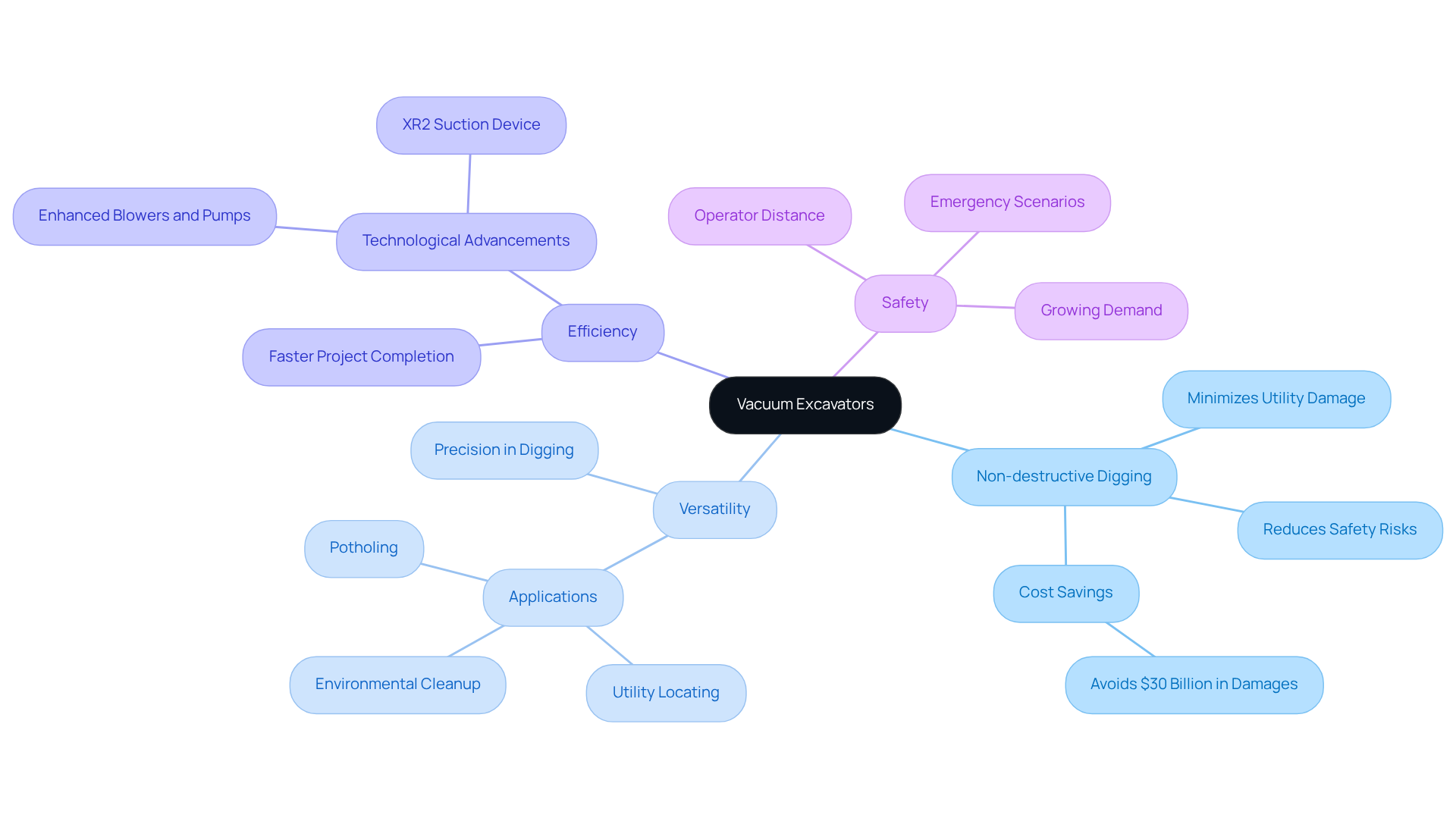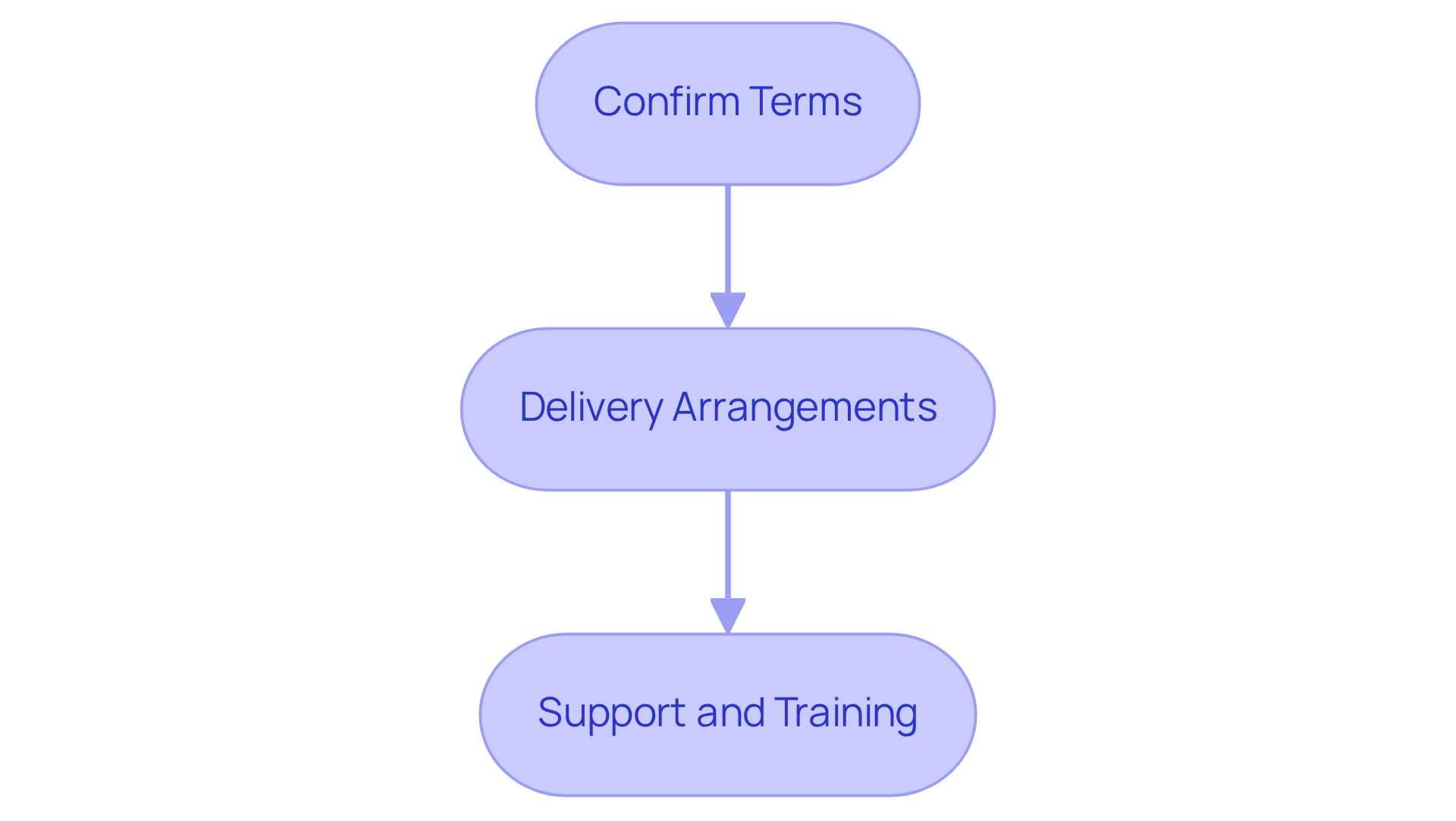Overview
Securing a vacuum excavator rental requires a strategic approach.
- First, assess your project requirements to determine the specific needs for your excavation task.
- Next, compare rental options to find the best fit for your project.
- Finally, finalize the rental agreement by confirming the terms and available support services.
Understanding crucial factors such as size, depth, soil type, pricing, equipment condition, and delivery arrangements is essential. These elements not only ensure a successful excavation project but also help minimize the risks and costs associated with traditional digging methods.
Key Highlights:
- Vacuum excavators, or hydrovacs, use high-pressure water or air for non-destructive digging, minimising damage to underground utilities.
- This method reduces safety risks and costly repairs, addressing the $30 billion annual damages to buried utility lines.
- They are versatile, suitable for utility locating, environmental cleanup, and potholing, enhancing project efficiency.
- Vacuum excavation is faster than manual digging due to advanced technology, improving project completion times.
- Safety is improved as operators are distanced from the digging site, essential in emergency scenarios.
- Before renting, assess project requirements: size, depth, and soil type to select the appropriate excavator.
- Pricing varies from $30 to $220 per hour and $150 to $2,000 per day; gather quotes to ensure competitive rates.
- Cheque equipment availability and condition to ensure it meets project needs and safety standards.
- Finalise rental by confirming terms, delivery arrangements, and support services, including training for safe operation.
Introduction
Understanding the nuances of vacuum excavators significantly enhances project outcomes, particularly in a landscape where safety and efficiency are paramount. These innovative machines minimize the risk of damaging underground utilities while offering versatility and speed that traditional methods cannot match.
As demand for these tools grows, the complexity of securing a rental that meets specific project requirements also increases. Navigating the rental process effectively ensures the right equipment is chosen, at the right price, and with the necessary support.
Understand Vacuum Excavators: Key Features and Benefits
Vacuum excavators, commonly known as hydrovacs, are cutting-edge tools that utilize high-pressure water or air to efficiently break up soil, which is then removed by a powerful vacuum system. Understanding their key features is essential for making informed decisions regarding your excavation needs.
- Non-destructive Digging: This innovative method significantly minimizes the risk of damaging underground utilities, positioning it as a safer alternative to traditional excavation techniques. For instance, hydro digging has been shown to reduce safety risks and costly repairs, ensuring a secure work environment. Notably, damages to buried utility lines account for an estimated $30 billion annually, highlighting the critical importance of employing vacuum methods to mitigate such risks.
- Versatility: Vacuum excavators are incredibly adaptable, suitable for a variety of applications, including utility locating, environmental cleanup, and potholing. Their precision in digging makes them ideal for installing underground utilities without compromising existing infrastructure, thereby enhancing project efficiency.
- Efficiency: Compared to manual digging, suction-based earth removal is remarkably faster, facilitating quicker project completion. This efficiency is further bolstered by technological advancements, such as enhanced blowers and water pumps that increase suction power while consuming less energy. The XR2 suction device exemplifies this innovation by effectively separating solids from liquids during hydro digging, showcasing the latest developments in the field.
- Safety: By keeping operators at a safe distance from the digging site, suction methods significantly reduce the likelihood of accidents. This is especially vital in emergency scenarios where traditional methods may present greater hazards. The growing demand for suction machines in utility tasks underscores their vital role in enhancing both safety and efficiency in excavation projects.
Grasping these characteristics empowers you to make informed choices about your digging requirements, ensuring that you select the most efficient and safe approach for your projects.

Identify Your Project Requirements: Size, Depth, and Soil Type
Before opting for a vacuum excavator rental near me, it is crucial to thoroughly assess your project requirements.
- Size: The size of the excavator is a critical factor that must align with the scale of your project. Larger projects typically necessitate bigger machines with higher CFM (Cubic Feet per Minute) ratings, ensuring efficiency and effectiveness.
- Depth: Understanding the necessary digging depth is essential. Vacuum excavators vary in their depth capabilities; standard systems can reach depths of 20-30 feet, while advanced models may extend to 60 feet, depending on soil conditions and equipment specifications.
- Soil Type: Identifying the soil type is vital for successful excavation. Softer soils are generally easier to excavate, whereas denser clay or rocky soils may require more powerful equipment to achieve the desired results. For instance, hydrovac excavation effectively handles various soil types, but the choice of equipment must reflect the specific challenges posed by the soil.
By clearly defining these parameters, you can ensure that you select the most appropriate digging equipment for your project. This approach not only enhances safety and efficiency but also minimizes disruption to the surrounding environment.

Compare Rental Options: Pricing, Availability, and Equipment Condition
When evaluating vacuum excavator rental near me options, it is essential to consider several key factors that can significantly impact the outcomes of your project.
- Pricing is a crucial element. Gather quotes from multiple rental companies to ensure competitive pricing. Be vigilant for hidden fees and clarify what is included in the leasing price, such as fuel and maintenance costs. Leasing costs for vacuum excavators can range from $30 to $220 per hour and $150 to $2,000 per day. Industry leaders emphasize the importance of transparency in pricing strategies to avoid unexpected expenses.
- Availability of the specific equipment you require is another vital consideration. Some leasing companies may provide a wider variety or more adaptable terms, which can be essential for achieving project deadlines. Notably, material handling machinery possesses 27% of the global construction equipment leasing market share, indicating a competitive landscape for equipment availability in the DFW area.
- Lastly, evaluate the Equipment Condition before completing your lease. Examine the equipment to ensure it is well-maintained and meets safety standards. Inquire about the last maintenance check and any repairs that have been conducted. Understanding lease costs and accessible machinery, including vacuum excavator rental near me, is essential, as the state of the equipment directly affects its performance and dependability on the work site.
By carefully analyzing these elements, you can secure a suction equipment lease that fits your budget and project requirements, thereby guaranteeing an effective excavation operation.

Finalize Your Rental: Confirm Terms, Delivery, and Support
To finalize your vacuum excavator rental, follow these essential steps:
- Confirm Terms: Carefully review the rental agreement to ensure clarity on rental duration, payment terms, and penalties for late returns. Understanding these particulars is crucial, as statistics indicate that 62% of contractors emphasize flexibility in lease agreements; thus, it is vital to be aware of your obligations. Furthermore, 84% of construction firms in the U.S. prefer leasing equipment over purchasing, illustrating the industry's shift towards equipment flexibility.
- Delivery Arrangements: Discuss delivery options with the leasing company. Confirm the delivery schedule and location to ensure alignment with your project timeline. Industry professionals assert that effective delivery arrangements can significantly impact project efficiency. As one specialist noted, "Clear communication with your leasing provider is essential to avoid delays and ensure smooth operations."
- Support and Training: Inquire about available support services. Many leasing firms provide training on safe and effective equipment operation. Access to assistance can be invaluable, particularly for complex machinery like a vacuum excavator rental near me, ensuring you can operate the equipment with confidence. Remember, renting construction equipment can save companies 30-50% of total ownership costs, making proper training vital to maximizing those savings.
By confirming these details, you can proceed with confidence, knowing that your lease is secure and tailored to meet your project requirements. Stay informed about the latest developments in equipment rental delivery options to ensure you are making the best decisions for your project.

Conclusion
Understanding the process of securing a vacuum excavator rental is essential for the success of any excavation project. By comprehending the intricacies of vacuum excavators, including their features and benefits, one can make informed decisions that prioritize safety, efficiency, and effectiveness in digging operations.
Key considerations such as project requirements—size, depth, and soil type—are pivotal in determining the right equipment for the job. Furthermore, comparing rental options based on pricing, availability, and equipment condition ensures that the selected vacuum excavator aligns with both budgetary constraints and operational needs. Confirming the rental terms, delivery arrangements, and support services solidifies a seamless rental experience, providing peace of mind throughout the project.
Ultimately, the successful rental of a vacuum excavator not only enhances operational efficiency but also mitigates risks associated with traditional excavation methods. Embracing this modern approach can lead to significant cost savings and improved safety on site. For those looking to rent a vacuum excavator, following these steps will pave the way for a successful and efficient excavation process.
Frequently Asked Questions
What are vacuum excavators also known as?
Vacuum excavators are commonly known as hydrovacs.
How do vacuum excavators work?
Vacuum excavators utilize high-pressure water or air to break up soil, which is then removed by a powerful vacuum system.
What is a key benefit of using vacuum excavators for digging?
A key benefit is non-destructive digging, which minimizes the risk of damaging underground utilities, making it a safer alternative to traditional excavation techniques.
How do vacuum excavators contribute to safety in excavation?
They reduce safety risks and costly repairs associated with damaging buried utility lines, which can account for an estimated $30 billion annually.
In what applications are vacuum excavators suitable?
Vacuum excavators are versatile and can be used for utility locating, environmental cleanup, and potholing.
What advantages do vacuum excavators offer compared to manual digging?
They are remarkably faster, facilitating quicker project completion, and are enhanced by technological advancements that increase suction power while consuming less energy.
What is an example of a technological advancement in vacuum excavation?
The XR2 suction device is an example, as it effectively separates solids from liquids during hydro digging.
How do vacuum excavators enhance safety for operators?
They allow operators to maintain a safe distance from the digging site, significantly reducing the likelihood of accidents, especially in emergency scenarios.
Why is there a growing demand for suction machines in utility tasks?
The growing demand is due to their vital role in enhancing both safety and efficiency in excavation projects.




